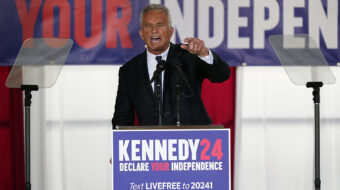In a vote that was heard around the world, reactionary Republicans along with some progressive Democrats in the House torpedoed a bill to stabilize financial markets. The compromise deal was better than what was initially proposed by Bush and Paulson, but did little to stimulate the economy or attend to the crisis of everyday living experienced by millions of ordinary Americans — who, it should be said, played by the rules. In fact, the plan goes in the opposite direction — it asks the American people to pony up to the tune of $700,000,000,000 even though they had no hand in causing this crisis.
As this point it is unclear whether some form of the existing deal will manage to finally squeak through. One thing is clear though — the American people are furious at Wall Street, the Bush administration and congressional leaders of both parties.
We should see this struggle over the bailout package as a skirmish, an eventful and seismic one, but a skirmish nonetheless, in a protracted struggle that labor and its allies can win.
One immediate line of action is to fight for a moratorium on foreclosures, debt forgiveness, and renegotiation of mortgage terms going forward. As long as the housing slump continues, the overall economy will slide downward and markets will churn.
Another is to demand the passage of a stimulus bill of a half trillion dollars, paid for by repealing the Bush tax cuts and by a special tax on financial transactions and institutions.
Still another is to impose a new regulatory environment on financial markets.
A fourth is to rapidly end the Iraq war and initiate a peace process in Afghanistan that helps the people of that country.
Finally, a debate over the merits of public takeover of our financial and energy complex is in order. Can our country, given the challenges we face now and through this century, afford to allow these industries to remain in the hands of profiteers?
Defeat for U.S. capitalism
The prevailing ideologies and practices that have driven U.S. capitalism for the past three decades have run up against their own contradictions and conjured up new and old oppositional forces both domestically and internationally. Notwithstanding the agreement on a bailout package, what we are seeing is a massive defeat for U.S. capitalism.
Financialization, financial-led globalization and neoliberalism are not yet corpses. But their future is very problematic, although I would add that history tells us that discredited ideologies and practices never exit from the stage voluntarily. They have to be pushed, and pushed by a new political coalition that commands broad-based support, is united in action and possesses the skills to construct a people’s alternative. But isn’t such a coalition, of which we are a part, forming before our very eyes?
Moreover, this coalition is ready to strike the first and absolutely necessary blow in a few weeks, that is, to elect Barack Obama and bigger majorities in the House and Senate by a landslide.
If people haven’t enough reasons to join this effort, the current implosion on Wall Street and the new constraints it will place on the federal budget should give them reason to roll up their sleeves and get the job done on Election Day.
From another angle, the implosion of U.S. financial markets has delivered a debilitating body blow to the hopes of U.S. imperialism for unrivaled hegemony in the 21st century. When combined with the Iraq disaster, the worldwide anger over global neoliberalism and structural adjustment policies, and the emergence of new global powers in nearly every region of the world — China in the first place, it signals a new stage in the hegemonic crisis of U.S. imperialism and the final chapter of a unipolar world. Giovanni Arrighi, a world systems theorist, says that at the end of what he calls a systemic cycle of capitalist accumulation, leading hegemonic states invariably pursue a path of financial expansion, and its aim is to re-inflate its declining powers. The Dutch pursued this path in the 17th century, followed by the British in the 19th and early 20th century — successfully for a while, but in the end to no avail. Both eventually lost their leading position in the world capitalist economy and were replaced by another hegemonic state that established the rules, conditions and institutional framework for capital accumulation and system-wide governance.
Much the same fate, according to Arrighi, now awaits U.S. imperialism. The only question that Arrighi doesn’t answer is: will U.S. imperialism adapt peacefully to new world realities or will it engage in, to use his words, a policy of “exploitative domination” to maintain its standing in the world? Bush tried the latter, but failed and will leave the White House in January completely discredited.
Longer-term processes
While the present turbulence was triggered by mountains of borrowing on thin capital reserves, predatory lending, risky financial instruments, deregulation and bubble economics, it is also the outgrowth of longer-term processes that go back to the mid-’70s.
At that time, the U.S. economy was stumbling along, battered by the combination of inflation, high unemployment, slow economic growth and a declining rate of profit across U.S. industries. The confluence of these conditions prompted Paul Volcker, then chairman of the Federal Reserve Bank, to drive up interest rates to nearly 20 percent. Not surprisingly, this spike in interest rates reined in inflation, restored confidence in the dollar, and attracted mobile capital around the globe to U.S. financial and real estate markets.
It also generated an unprecedented shift of wealth in favor of the very wealthiest families and financial institutions, and set off an explosion in the financial sector in terms of its size, scope of activities, debt obligations and players.
At the same time, rising interest rates slowed down the economy, big swathes of industry shut their doors, union jobs were lost, wages stagnated, the social safety net was hollowed out, entire communities nearly collapsed and the labor movement was thrown on the defensive. Not since the Great Depression has productive capital been destroyed, living standards driven down and the relative strengths of competing financial and non-financial corporations reshuffled so fast and so broadly.
Much the same was occurring in the global South. In these countries finance-led globalization was responsible for massive drops in living standards, astronomical indebtedness to U.S. banks, privatization of industries and services, currency devaluations and unconscionable poverty. It was the convergence of these conditions that set into motion the eruption of political movements in Latin America that are either winning or contesting for state power.
Of course, it took more than shock therapy in the form of high interests rates to effect changes of this magnitude. If Volcker struck the first blow, it was the Reagan administration entering the White House less than a year later that was the main political agent of this upheaval.
The Reagan counterrevolution
At the ideological level, the Reaganites said that government is best that governs least; that markets are self-correcting; that income inequality is a good thing; that deregulation and privatization are the best fix for what ails the economy; that we live in a post-civil-rights era where affirmative action has no place; and that tax cuts for the rich trickle down to working people, thereby lifting all boats.
At the political level, the Reaganites framed the agenda of struggle and employed state power in its varied forms with a ruthlessness seldom seen. Remember PATCO.
Finally, at the economic level, the Reaganites dismantled much of the old Keynesian model of economic governance at the state and corporate level — a model that had its origins in the New Deal and was expanded by successive administrations in the next three decades. It rested on a measure of class compromise, societal obligations, formal equality and expansive macro-economic policies that favored broadly shared prosperity.
In its place, they constructed a new model of economic governance, popularly called neoliberalism. Its main features included flexible production networks on a global scale, union-busting, deregulation, low-wage labor, low inflation, free flow of goods, services and capital, shrinkage of the public sector, re-embedding of racist and sexist practices into political, economic and social life, restructuring of the state’s role and functions, and reassertion of finance.
It is against this backdrop that I will discuss financialization in Part 2. (Read Part 2 here.)












Comments